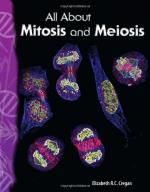|
This section contains 1,296 words (approx. 5 pages at 300 words per page) |

|
Meiosis, also known as reduction division, consists of two successive cell divisions in diploid cells. The two cell divisions are similar to mitosis, but differ in that the chromosomes are duplicated only once, not twice. The end result of meiosis is four daughter cells, each of them haploid. Since meiosis only occurs in the sex organs (gonads), the daughter cells are the gametes (spermatozoa or ova), which contain hereditary material. By halving the number of chromosomes in the sex cells, meiosis assures that the fusion of maternal and paternal gametes at fertilization will result in offspring with the same chromosome number as the parents. In other words, meiosis compensates for chromosomes doubling at fertilization. The two successive nuclear divisions are termed as meiosis I and meiosis II. Each is further divided into four phases (prophase, metaphase, anaphase, and telophase) with an intermediate phase (interphase) preceding each nuclear division...
|
This section contains 1,296 words (approx. 5 pages at 300 words per page) |

|


